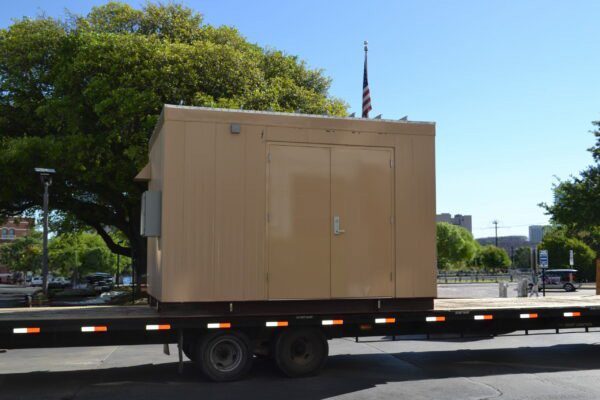Many people approach us and ask whether they should mount their equipment enclosure to their equipment skid, or to Terra Firma, that is, slab on grade. Some say it’s just a matter of preference, but we think, like with most decisions, that some careful research will reveal which option works best for your application in the long run. Full transparency, we are insulated panel manufacturers who are part of the process in either application.
What Are Skid and Slab Equipment Enclosures?
What is an outdoor equipment enclosure? Why does it matter where or what it’s mounted to? What are the differences between skid vs slab mounted equipment enclosures? The what is relatively self-explanatory. Equipment enclosures are buildings with a higher than normal insulation value (vs typical construction), built to withstand outdoor elements that are used to protect industrial equipment stored within. Equipment enclosures can be either mounted on an equipment skid or a mounted slab on grade.
Skid Mounted Installation
When the equipment enclosures are skid mounted, installation to the skid is usually done within the confines of an integrator’s shop and shipped as a complete unit to the final destination.


Slab Mounted Installation
The alternative to skid mounted is slab on grade mounted. Slab mounted equipment enclosures are generally shipped palletized flat and assembled at the final installation destination.
What Is The Difference Between Skid Vs Slab Mounted Equipment Enclosures?
Whether it is skid or slab mounted, the construction of the equipment enclosure only has minuscule differences. One minor difference that may differentiate the two is how the shelter is anchored down. However this detail is relatively minor and doesn’t affect cost.
Structurally, both skid and slab mounted equipment enclosures require a design that is engineered for the final installation destination to meet the needs of seismic and environmental certifications. Details that are carefully considered during the design and engineering process include panel thickness, finish, access, venting and fire ratings among many others and are consistent with both skid and slab mounted equipment enclosures.
While the differences are not as obvious as construction type or design, they certainly are no less important.
State Restrictions And Labels
One difference that requires consideration is how the enclosure is viewed, or classified by the destination municipality. This can depend on whether it was shipped in pieces (slab mount) or as an assembled unit (skid mount). States such as Washington require a label on the entire unit if it was shipped assembled and not just the individual components. Obtaining a state label in this case can be much more difficult, especially for custom units.
Shipping
Transportation of your unit changes if it is a fully assembled enclosure. Shipping an oversize skid mounted equipment enclosure across the country is no easy feat. Even with these differences we find integrators prefer to build the equipment skid in their shop, have the insulated shelter sent to them, and then installed on the skid. This process is easier to manage in a controlled environment and it allows them to add finishing touches such as adding electrical (lighting, fans) and mounting any necessary controls or equipment that was part of the design prior to leaving their shop. Not to say that those items can’t be done in the field but you lose an amount of control once you leave the confines of a shop.
Installation
Regarding the actual installation of the insulated shelter, skid and slab mounted equipment enclosure installation is very similar. The scope is the same with the main difference being the environment the installation is taking place in. Weather, site conditions, or other trades needing access can all slow or stop the installation if timing or coordination isn’t spot on. What could take 1-2 days in an integrators shop may take 2-3 days and possibly involve another trip when installing in the field, especially if installers have to wait for other trades to complete their work.
How To Choose Between Skid Mounted And Slab Mounted Enclosures.
How do you know which type of shelter is best suited for your application? Consider the points we’ve brought up: site conditions, the municipality governing your project, timing and logistics. If you want control as an integrator of the process and product from start to finish then you will likely choose to install the shelter on the skid, in your shop and ship as a complete unit. If timing is short and you have confidence in the site conditions and ability to coordinate multiple trades at the same time, you may opt to ship your equipment to the site and then have the shelter built around it.
Conclusion
Either way, the ultimate goal is to protect the valuable equipment within. Choosing an equipment enclosure is the first step in ensuring equipment lasts and performs. Skid or slab mounted as we’ve seen do not have many obvious differences. Make your choice based on the entire set of circumstances surrounding your project and build it well! If you have any questions, that’s where we at KPS Global come in. From design and engineering to installation and coordination with you or your integrator, we are here to help. Contact us today to request a meeting or request a quote.
Author

Brandon Powers
Brandon Powers is a seasoned professional with over 34 years of experience with KPS Global in the insulated panel industry. Currently serving as the Industrial and Scientific Sales Manager at KPS Global, Brandon utilizes his industry knowledge and expertise to provide custom insulated panel solutions for customers across a wide range of industries and applications.



